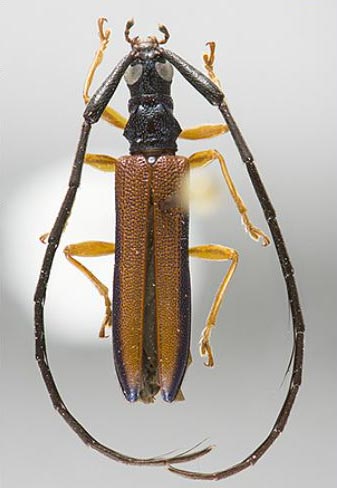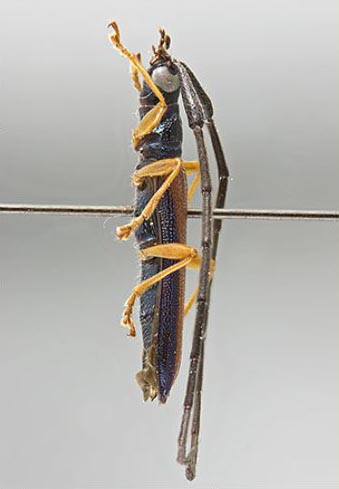 |
Disteniinae
Classification
Introduction
- The subfamily Disteniinae Thomson, 1861 currently contains ~365 species in 4 tribes. Photographs of 18 exemplar specimens are currently available for this subfamily. This relatively small family has traditionally been classified as a subfamily of Cerambycidae.
Diagnostic Features of Adults
- Similar to some Cerambycidae but with distinct oblique, setose groove along the outside edge of the mesotibia.
- Length 4-34 mm. Elongate, slender; Antenna 11-segmented, filiform, longer than body (e.g., Distenia, Nethinius, Typodryas) or not (e.g., Dynamostes, Cyrtonops, females of Aiurasyma, and some species of Elytrimitatrix); insertions exposed. Prosternal process complete, incomplete or absent. Procoxae projecting or not with exposed or concealed trochantins. Procoxal cavities slightly transverse to circular, externally open or closed, internally open or closed. Mesocoxal cavities narrowly to very widely separated, laterally open or closed. Tarsi pseudotetramerous. Abdomen with 5 free ventrites (Lawrence, 2007).
Diagnostic Features of Larvae
- Larva. In general form and structure they are strikingly aberrant from the usual cerambycid type. This divergence is due to the possession of a peculiar combination of lepturine and cerambycine characters, the latter, however, predominating. The position of the occipital foramen is posterio-dorsad. All structures on the dorsal surface conform to the type of Lepturinae, and the ventral mouth structures to that of the Cerambycinae. The mandible is of the type characteristic of the Lamiinae. They suggest a very primitive type of cerambycid larva. The peculiar tentorial structures and the attachment of the skin of the prothorax directly to the submentum has been observed in no other cerambycids. Adapted from Craighead (1923).
The characters of the Disteniinae may be briefly summarized as follows: Head transverse, dorsal margins of the epicranial halves behind front entirely separated; occipital foramen posterio-dorsad; tentorium very broad, gula and hypostoma not evident. Mandibles rather elongate from side; apex slightly produced, cutting edge obliquely truncate, short. Epistoma not produced over clypeus, three epistomal setae. Clypeus trapezoidal, filling space between dorsal condyles of mandibles. Submentum attached to the collar; maxillae movable, cardo visible; maxillary articulating lobe full; palpifer small, joint-like; lacinia borne on stipes. Antennae frail, retractile. Prothorax with presternum and epipleurum anteriorly fused. Epipleurum large, rectangular; eusternum not sharply defined; coxae small, widely separated, and situated at extremities of sternellum. Mesothoracic spiracles not protruding into prothorax. Legs moderate in size, weak. Epipleurum protuberant only on last three abdominal segments; pleural disc never present. Spiracles in a well-defined, elliptical, protruding region. Adapted from Craighead (1923).
Geographic Distribution of Subfamily
Biology and Economic Importance
- Adults on plant surfaces; larvae in wood; xylophagous (Lawrence, 2007).
Selected References to Adult Specimens
Selected References to Larvae Specimens
|  |

Abauba napoensis
Santos-Silva & Tavakilian, 2009; dorsal
Disteniidae:Disteniinae
Photograph © N.P. Lord

Abauba napoensis
Santos-Silva & Tavakilian, 2009; head
Disteniidae:Disteniinae
Photograph © N.P. Lord

Abauba napoensis
Santos-Silva & Tavakilian, 2009; lateral
Disteniidae:Disteniinae
Photograph © N.P. Lord
|




